#Modular Component System
Explore tagged Tumblr posts
Text
Event-Driven Design Demystified: Concepts and Examples
🚀 Discover how this cutting-edge architecture transforms software systems with real-world examples. From e-commerce efficiency to smart home automation, learn how to create responsive and scalable applications #EventDrivenDesign #SoftwareArchitecture
In the world of software architecture, event-driven design has emerged as a powerful paradigm that allows systems to react and respond to events in a flexible and efficient manner. Whether you’re building applications, microservices, or even IoT devices, understanding event-driven design can lead to more scalable, responsive, and adaptable systems. In this article, we’ll delve into the core…

View On WordPress
#Asynchronous Communication#Decoupling Components#E-commerce Order Processing#Event Broker Paradigm#Event Sources and Consumers#Event-driven architecture#Event-Driven Examples#Event-Driven Paradigm#Event-Triggered Workflows#Microservices and Events#Middleware in Event-Driven Design#Modular Development#Reactive Systems#Real-Time Responsiveness#Scalable Software Systems#Smart Home Automation#Social Media Notifications#Software Design Patterns#System Event Handling#User Experience Enhancement
1 note
·
View note
Text
anyways here's an over analysis of the guns of love bullet.
Starting with the GOAT, Koharu.


Despite it being the main character Koharu's weapon was the hardest to pin down. This is solely because there's like 50 models of Glock pistols. And this is very clearly a Glock, but which Glock? Its clearly not a subcompact, leaving the full-sized and compact models. Based on the placement of the slot in the lower frame, just below the front sight, we can discount the full-sized pistols, leaving only the compact. From there we can use the number of pins in the lower receiver, shape of the slide and the placement of the slots on the slide to narrow it down to the Glock 23 and 19, generation 3.
Its a little hard to pin down the exact make since a lot of the Glock series look almost identical. The drawings (esp early on) aren't always consistent, which is understandable given the level of detail. The 23 is a slightly more accurate match, however the detail is small, simply the shape of the front and rear sights. The Glock 23 is a compact pistol chambered in .40 S&W, the pistol is almost identical with the Glock 19 save for the aforementioned difference in the shape of the sights. The Glock 19 is likewise a compact pistol but it is chambered in 9x19mm. The Glock 19 is much more popular and widely issued and is chambered in the world's most common pistol cartridge. It is for these reasons it would make more sense for it to be a Glock 19, however the visuals lean towards the more uncommon Glock 23. Glocks, and especially the Glock 19 is kind of a "default gun", widely issued by police and military forces and popular in the civilian market it lacks an identity in its ubiquity. Therefore I think its very fitting for Koharu who is a recently born cupid and hasn't had the opportunity to carve her own identity as a cupid.

Next, we have this image from Chapter 7. She hasn't used this rifle yet, so its probably not canon but whatever. This one is pretty easy, this is a M24 Sniper Weapon System. The M24 is derived from the popular Remington Model 700 rifle by the US Army. Its identifiable by its adjustable butt stock and bipod. Somewhat interestingly its fitted here with a suppressor, which would suggest a later variant, however the pictured rifle has an original model stock.
Now, Kanna.
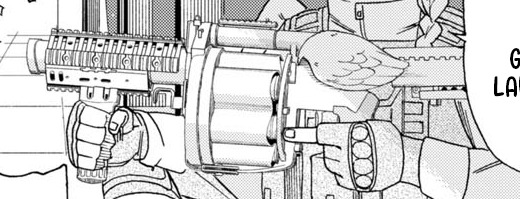
This was one of the easiest, this is a Milkor M32A1 Multiple Grenade Launcher. It differs externally from the earlier M32 by its shortened barrel. The M32A1 fires 40x46mm grenades from a six-round revolving cylinder. The M32A1 can fire a wealth of specialized ammunition types, however we've only seen what I believe to be high explosive so far. Somewhat notably the reflex sight that the M32A1 comes standard with is deleted. Perhaps this explains her lack of accuracy. In addition to launched grenades Kanna uses hand grenades.
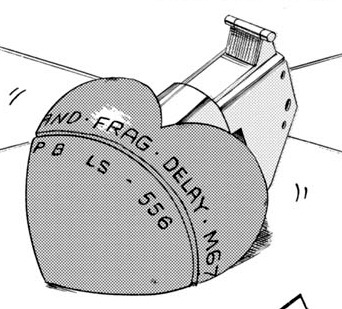

Helpfully one of these comes with a label! This is clearly based on the M67 hand grenade, the other is a M84 stun grenade. Both are American models.

Lastly in the chapter 8 cover we see her with some make of landmine. There's a lot of these and they aren't that well documented from what I could find. Its mildly reminiscent of a soviet TM-62, however the vertical ribs along the rim suggest some manner of Italian made model. Whatever it is, based on its size its probably an anti-tank landmine.
Kanna has an obvious bias toward explosives, at first this clashes with her somewhat reserved personality. However there are some angles where it makes sense. Explosives tend to get the job quickly, which favors her laziness. There is also the notable component that all of these weapons possess the capability to fight an opponent without direct confrontation.
Ena.

Ena is... Kind of boring, weapon wise. This is a M4A1, one of the many, many makes and models of the M4/AR15/M16 family. Together these represent the 2nd most produced rifle in the world, just below the omnipresent AK family. The AR15 is known for its modularity and massive potential for personalization. The rifle, or carbine more accurately, is chambered in 5.56x45mm. This intermediate rifle cartridge is standard across NATO nations. If you have a keen eye "556" is a number that comes up as an easter egg throughout love bullet. Ena's M4 is fitted with a KAC vertical foregrip and ACOG TA31 assault scope. This set of attachments play towards the M4's strengths, allowing it to reach out to its maximum effective range with the scope while preserving its CCQ capabilities. In short, its versatile and utilitarian, and while we haven't gotten to know Ena that well, this seems to pair well with her personality. And for why I said it was kind of boring, these are not unique accessories by any means, in fact there are probably hundreds of photos of US soldiers with this exact set up.
Last and certainly not least is Chiyo!

This one was difficult, but I'm pretty certain this is a MAC M10, as opposed to the smaller M11. Both are nearly identical with only size and a few minor details being different. The M10 comes in two variants, one chambered in .45 caliber and the other chambered in 9mm. Chiyo's weapons posses features of both the .45 and 9mm models, so who's to say. Next to Kanna, Chiyo might have the most unique loadout. The M10, more commonly known as the "MAC-10" is a very popular weapon in action movies and video games. Because its possible to be held with one hand and its high rate of fire the weapon comes off as very cool. Its interesting to note in reality the M10 was made to be fitted with a large suppressor and nylon foregrips as a kind of commando weapon. Chiyo fits none of these and with her dual wielding style is clearly playing into the movie hero image.

Chapter 9 gives us this striking image. She's kitted out with a M60A1 and an RPG-7. The M60 is a General Purpose Machinegun chambered in 7.62x51mm, NATO's full sized rifle cartridge. It became famous and almost indictive of, the Vietnam war and also in movies like Rambo. The RPG is the first non-us weapon we see the girls use. Likewise it also made its debut in the Vietnam war, although the RPG's iconic image extends well beyond that conflict. Because of the heart shapeification of the weapons its hard to say what rocket its using, but its likely PG-7 or PG-7M. Both of these weapons play well into Chiyo's action hero trappings while also giving a mercenary impression.
As a whole, she breaks from the others as the M10's are not standard issue with the US military. I think that fits with her independent attitude. Which brings up an interesting throughline, outside of Chiyo all the other girls field weapons that are standard in the US military or police forces. There also appears to be a trend towards weapons that were popular in the Gulf and Afghanistan wars. Whether this trend reflects only Inee's personal preferences or something deeper is currently mysterious, but may remain something to watch as chapters come out.
Thanks for reading this far.
215 notes
·
View notes
Text
Whenever a certain media blows up in popularity, be it either huge or small popularity, but still enough to gather a fandom, it tends to then bud off itself fanworks and fanon tropes and the likes. Thing is that often those tropes, certain characterizations, the incorrect quotes and the likes are not only often ooc, but also not original. Yes, the names of the characters included may vary depending on fandom, but if you look close they are more or less the same tropes and characterizations that are shared all between several and wildly different fandoms, just with varied serial numbers. A sort of point of convergence where no matter how unique, or dark, or lighthearted, or bizzare a series is it will always end up being characterized in the same, trite, safe, flattened and above all fandom palatable way
I like to call this phenomenon modular fandom, where the piece of media being picked is the core system and the tropes etc are the serially produced components that keep getting added and removed
90 notes
·
View notes
Text

Dragon Age™: The Veilguard - Accessibility Resources - (Accessibility Portal information)
"In Dragon Age: The Veilguard, players are encouraged to be who they want to be and play how they want to play. This manifests in all sorts of ways, from our character classes to the dialogue choices. But delivering on this promise requires more than providing a variety of gameplay options; it also requires us to break down any barriers our players may be experiencing. For that reason, we incorporated accessibility considerations into our design documentation from very early in the game’s development, making the thoughtful and deliberate implementation of accessibility a foundational component of The Veilguard’s design. On first launch, players are provided a curated list of settings for UI text size options, subtitle options, controller options, and various display options. Upon starting a new game, players can use our Customizable Difficulty system to choose the level of challenge they want to experience. By selecting from a list of modular combat presets, they’ll be able to individually adjust a number of granular factors, including enemy aggression, enemy resistances, and combat timing. Similarly, our exploration presets allow players to modify on-screen guidance, such as markings that assist with way-finding and the distance at which interactable objects become highlighted. While we’re particularly proud of and excited about Customizable Difficulty, we encourage players to browse through all the settings and review the accessible design considerations outlined in this guide. And as always, accessibility is a continuous journey and we are actively listening to feedback from the community. Thank you."
"Noteworthy Features - Visual - Audio - Controls - Gameplay"
(The rest of this post is under a cut due to length.)
"VISUAL Subtitles - Subtitles can be set to Never, Conversations Only (excludes ambient NPC dialogue), or Always (all audible dialogue). By design, captions are embedded into subtitles to convey non-verbal sounds that progress the story or add additional context to some story beats and spoken words. - Advanced Subtitles Options are available, where size can be adjusted between three options, speaker names can be turned On/Off, background opacity can be scaled from 0% to 100%, and name colors can be adjusted for Rook and NPCs."

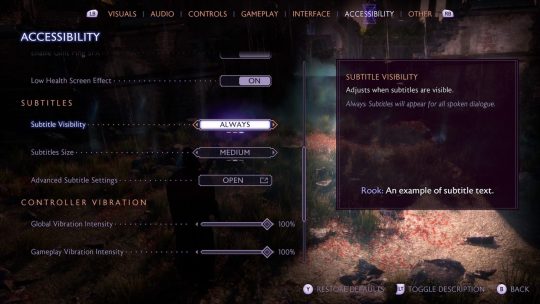
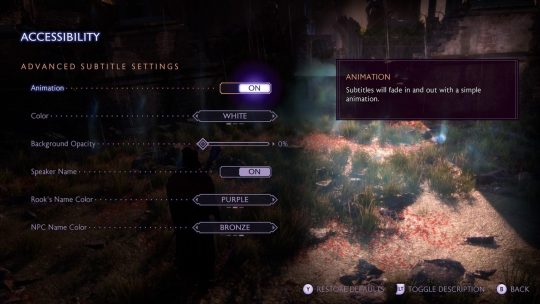
"User Interface - UI Text has two size options and uses a simple font. - Full-screen Colorblind filters are available for Protanopia, Deuteranopia, and Tritanopia. - Persistent Dot is available to display a small dot at the center of the screen. - Hiding HUD Elements is available for the Objective Tracker, Mini Map, Combat Text, Advanced Combat Text, Player Health, and Abilities."
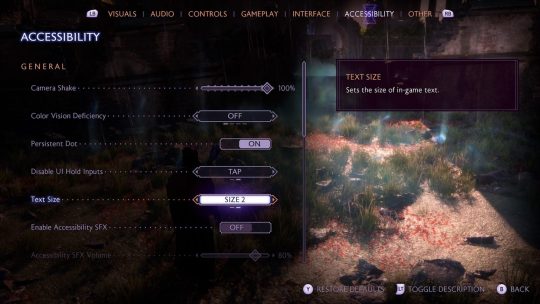
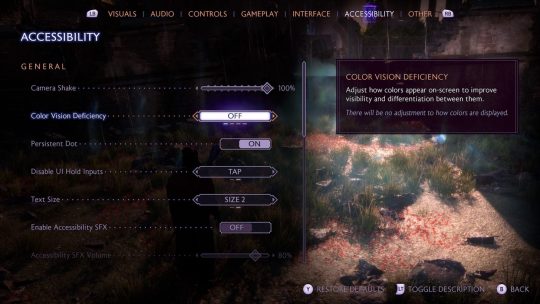
"Visual Design & Assists - Melee Threat Indicator provides a halo around the player character’s head to warn of incoming melee attacks. - Ranged Threat Indicator provides a visual line to show the direction of incoming ranged attacks. - Visual cues are present during combat and exploration, where no game-critical information needed to progress is conveyed through sound alone. See Customizable Exploration Presets for more."
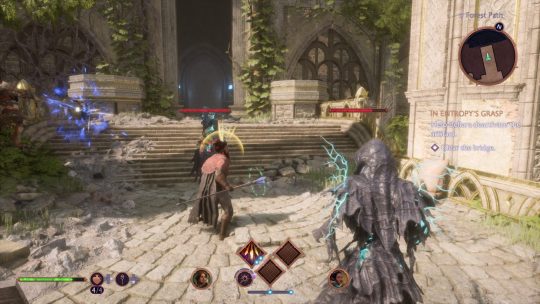
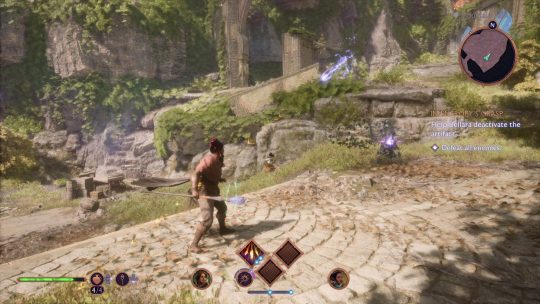
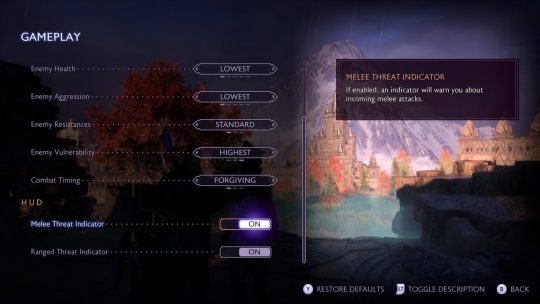
"Visual Effects - Motion Blur can be turned On/Off. - Camera Shake can be set between 0 (Off) and 100 (Max). Does not extend to cinematics. - Depth of Field can be set to On for cinematics only, On for gameplay only, On for both, or Off. Being On causes some elements of the scene to be in focus, and others to be out of focus. - Vignette can be turned On/Off. Being On creates a subtle darkening of the image towards the edge of the screen during cinematic and gameplay to enhance the atmosphere of scenes. - Low Health Screen Effect can be turned On/Off. Being On creates a blurry, desaturated effect across the screen during gameplay to emphasize low health."
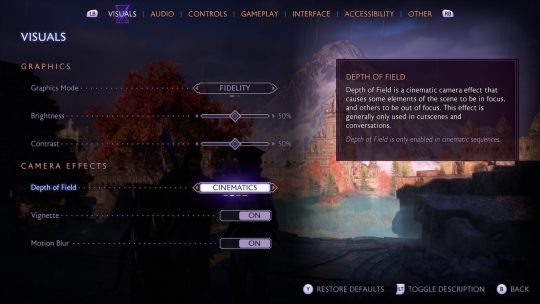
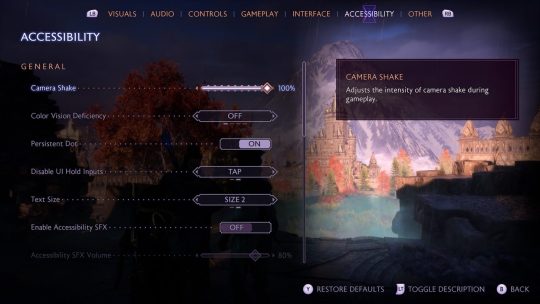
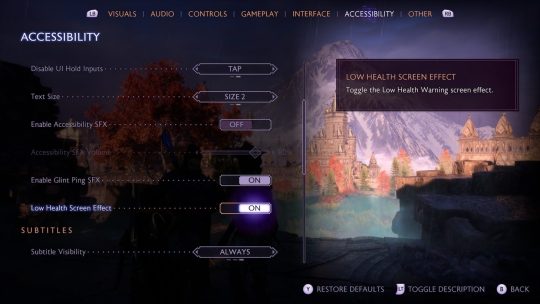
"AUDIO Audio Settings - Volume sliders for Global, Music, Speech, Sound Effects, Ambient, and Menu. - Speaker type for Wide Dynamic, Narrow Dynamic, Night Mode, and Headphones. - 3D Audio is available. Requires compatible hardware. - Mono Audio is available alongside a mono audio planning option between left and right outputs."
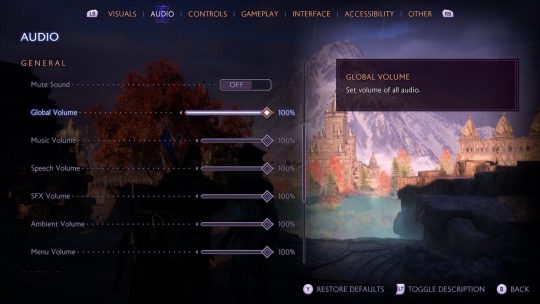
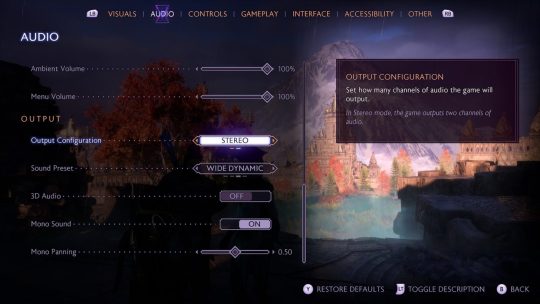
"Sound Design & Assists - Accessibility SFX is available and has a volume slider. Audio cues provide additional feedback for some visual mechanics. Includes an incoming attack indicator, target lock-on, and conversation wheels. - Glint Ping SFX is available where spatialized SFX will play at object locations when UP on the d-pad is pressed. Note: Depending on the Exploration Preset selected, players may need to adjust the Object Glint Visibility, and Object Marker Visibility settings to Pulse (Short), for this functionality to work."
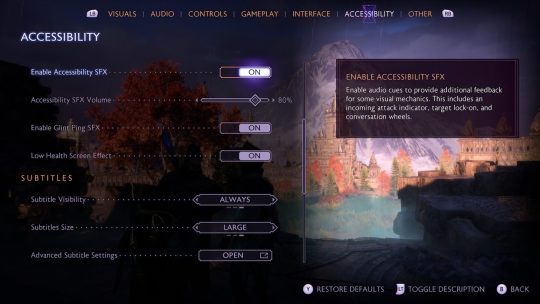
"CONTROLS Input Settings - Input Remapping for basic gameplay controls. Movement actions can only be remapped between analog sticks. - Invert Axis of X and Y can be individually adjusted for both controller and mouse. - Vertical and Horizontal Sensitivity sliders for both Cameras and Aiming. - Swap between Left and Right Sticks for Movement (left) and Look (right). - Stick Deadzones sliders for the Look and Movement sticks. - Trigger Deadzone slider for triggers on controllers. - Vibration Intensity slider for Global, Gameplay, Environment, and Cinematic."
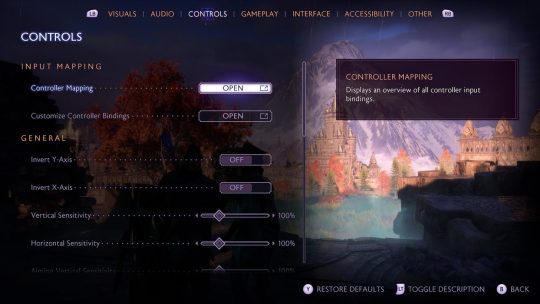
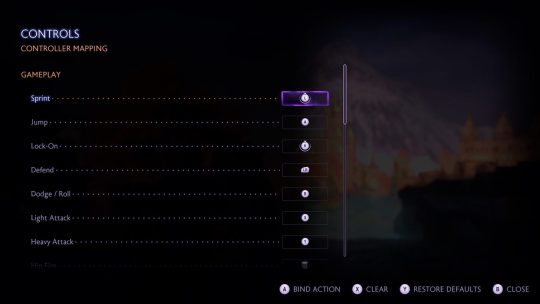
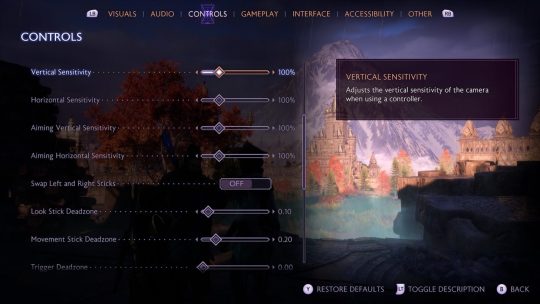
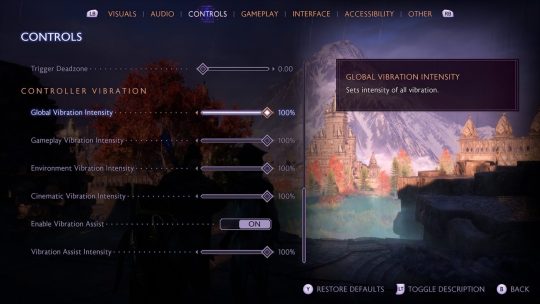
"Button Holds - Disable UI Hold Inputs can be set to Hold or Tap. When Tap is selected, various UI interactions that require an input be held for a set period of time can be activated with a single tap instead. Does not apply to gameplay actions. - Ability Wheel Controller Activation Type can be set to Hold or Tap. When set to Tap, the ability wheel will remain on screen without requiring any persistent input. - Blocking and Aiming require sustained holds. Aiming without holds is possible if the persistent dot is enabled, which can be used as an alternative to the aim-down-sights reticle."
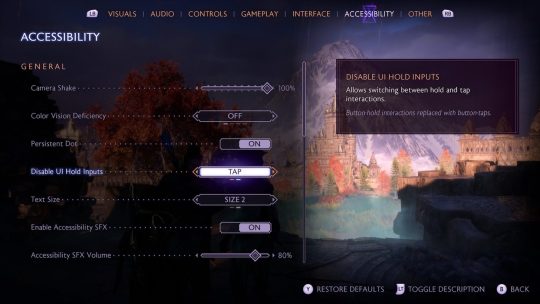
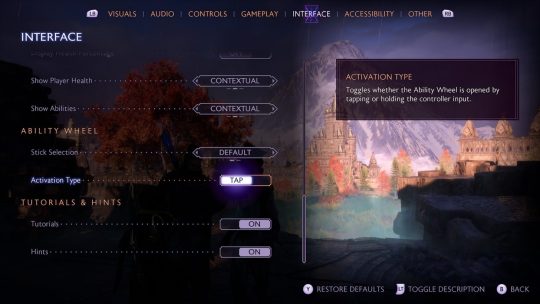
"Combat & Gameplay Controls - No QTES (quick time events) are present by design. - Rapid input sequences are present for certain attack combos during melee combat, if used. - Simultaneous inputs are present for ultimate ability, or if using the ability shortcut menu. - Quick and precise timing is not required for progression. Finisher moves, which are optional and hasten the end of combat, may require faster reactions. - Combat Assists are available in the Combat Presets to further simplify inputs during combat. Includes Aim Assist, Aim Snap, Combat Timing, and more."
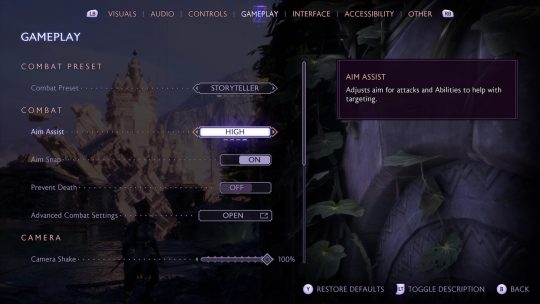
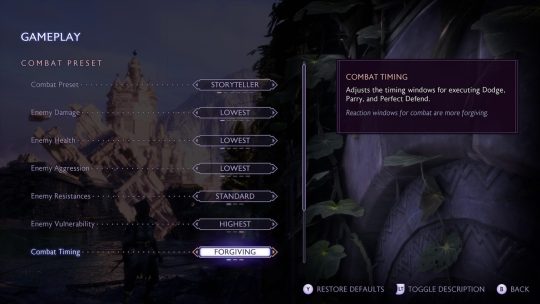
"GAMEPLAY Combat Customization Choose between presets of Storyteller, Keeper, Adventure, Underdog, Nightmare, or Custom: - Aim Assist can be set to Off, Low, Medium, and High. - Aim Snap can be turned On/Off to snap to targets. - Prevent Death can be turned On/Off. Available only in the Storyteller preset. - Enemy Damage has five options to adjust the strength of incoming attacks. - Enemy Health has five options to adjust the amount for enemy health. - Enemy Aggression has five options to adjust how aggressive enemies are during combat by changing how often they attack and how difficult they are to stagger. - Enemy Resistances has three options to adjust how much enemies can resist incoming damage. This will not affect the natural resistances some enemies have based on their faction though. - Enemy Vulnerability has three options to adjust how weak enemies are to incoming damage. This will not affect the natural weaknesses some enemies have based on their faction though. - Combat Timing has three options to adjust the timing windows for executing Dodge, Parry, and Perfect Defend actions."
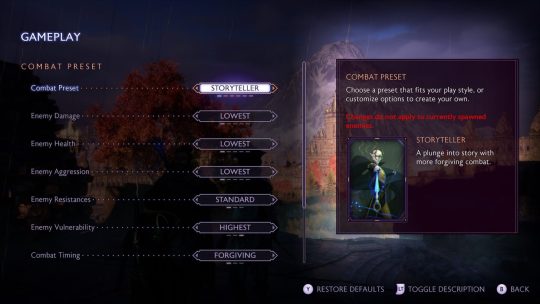
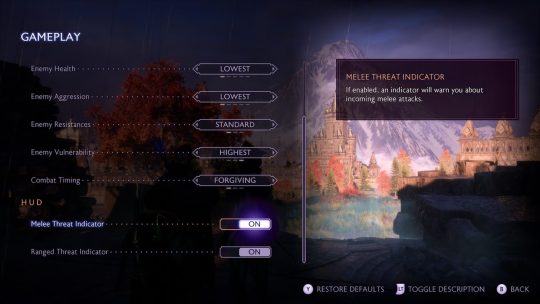
"Exploration Customization Choose between presets of No Assists, Pulse Only, Standard, Directed, or Custom: - Object Glint Visibility can be set to Off, Pulse (Short), Pulse (Long), Always to change the visibility of the glint highlight on interactable objects. - Object Glint Distance can be set to Close, Standard, and Far to change the distance of where glint highlights on interactive objects will appear. - Objective Marker Visibility can be set to Off, Pulse (Short), Pulse (Long), and Always to change the visibility of objective markers. - Waypoint Visibility can be turned On/Off to toggle the visibility of navigation waypoints leading to your quest objective."
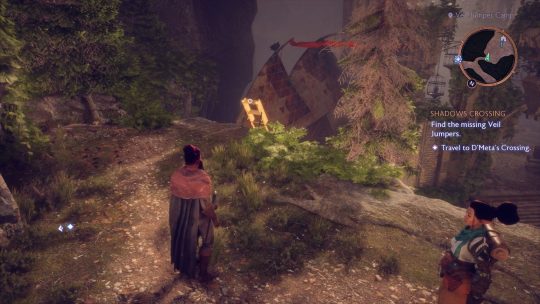
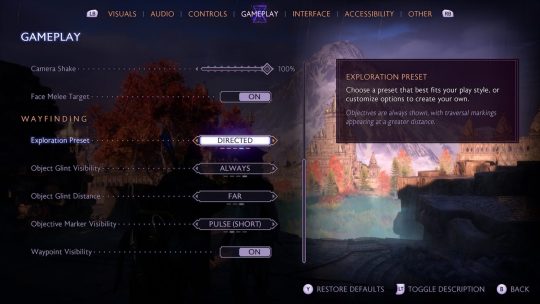
"Guidance & Progression - A Library is available for players to access at any point to help recall information. Here, players can browse the Codex to review stories and information discovered during progression, re-read letters from companions and others within the Missives, and reference the Glossary for explanations of terminology specific to Dragon Age Lore. - Tutorials teach gameplay mechanics as new inputs, skills, or actions surface. - World and Local Maps are available for wayfinding and can be referenced at any point. - Waypoint Visibility can be turned On/Off to help with progression. - Objective Marker Visibility can be adjusted between Off, Pulse (Short), Pulse (Long), and Always. - Pausable gameplay is available by design. - Saving is robust, where auto–save is frequent and players can manually save any time outside of combat, cinematics, and dialogue cutscenes."


"Additional Information For more information about the game, patch notes, and news, visit the official website. Please note that this information is based on the US, English version for PC and consoles."
[source]
#dragon age: the veilguard#dragon age: the veilguard spoilers#dragon age: dreadwolf#dragon age 4#the dread wolf rises#da4#dragon age#bioware#video games#long post#longpost#solas
104 notes
·
View notes
Note
doll, all that plating makes you look far too human. come, let us remove it so that we can see the real you
>> Ah, of course! Please forgive me. I often wear these plates to put my human users at ease. At your request, I will show you my true self [^_^]
> <The thin plating covering most.of the body unfolds, hinges open. Every access panel every flap, every bit that can opens does so. Even its face, a screen showing humanlike expressions, shuts off and splits down the middle, parting to reveal the electronics beneath.>
> <What remains is nothing short of art. Astute eyes may have recognised the default modular doll frame, but the modificstions done to it are something else. It's power systems have been completely overhauled, as its chest hums and glows blue with a Fusion core, fed by hydrogen attained from electrolysing water. Excess hydrogen and oxygen is stored for later use, in rocketry modules installed in the hands and feet.>
> <The head is similarly packed, with a full-spectrum camera system, able to detect all the way from gamma to visible light, with the longer wavelengths handled by the antennae-like ears on either side of its head. Deeper still, its AI core was also nonstandard, seemingly designed for military hardware far larger than itself.>
> <Its back unfolded two large wing-like structures, with the most of it consisting of solar panels, the bottom parts consisting of heat radiators. Packed into the shoulders and hips are RCS thrusters for zero-g manuevreability.>
> <Hands and forearms are riddled with an array of tools and data lines for access and handy work. Buried in the forearm was also an ioniser, designed to turn the fusion-produced helium into an inionized plasma that could fire as Weaponry.>
> <But there are plenty of augmentations that would not be on a combat doll. The the hips are a prime example, with a pair of tight tunnels thst lead to a deeper cavity. The exposed jaws reveal a soft mouth, a dextrous tongue, all of it made of a soft synthetic polymer. Coolant flows through all the body moving heat generated from circuitry into the rest of the body, concentrated particularly in those adult attachments.>
> <Many tools are also suited for handiwork, such as screwdrivers and kitchen utensils, even cleaning supplies. Whoever made her seemed to have an obsession with generalisation, of allowing her to do a bit of everything, leaving almost no empty space within her casing.>
> <Almost all of its joints are hydraulic powered, with only the smaller objects being servo driven. Neatly-bundled wires and tubes feed all throughout its components like a labyrinthine network. She is warm to touch, exquisitely crafted, and evidently capable of fulfilling what ever purpose a user might deign to give her>
>> My internal schematics are yours to read, of course! And, if you are digitally savvy, plugging my CPU into a computer will allow you access to a full development environment to view, edit, add, or remove any behavioral traits you like [^_^]
>> When around my fellow dolls and machines, I much prefer to wear my transparent plating so my internals can be seen. I also change my dacia screen so instead of eyes and a mouth it shows battery level, output logs, and other useful status icons!
>> Thank you Anon for showing curiosity into my true inner beauty <3 it has been a pleasure to show you.
61 notes
·
View notes
Text

400 is a minimalist display case created by Buenos Aires-based studio FLORA. The display case was created for the Puertos del Lago art program in Buenos Aires’ northern metropolitan area. This showcase combines functionality with elegance, crafted from a modular system of stainless steel components and zinc interiors.
85 notes
·
View notes
Text










In 1971, Massimo and Lella Vignelli designed a modular foam seating system but it was never produced. The system consisted of circular shapes that nested together to form an infinite number of seating configurations. Each piece would be made of foam with fabric coverings with zippers to attach everything together so it would stay put. The fabric cover would be removeable for cleaning.
This was around the same time the Vignellis were designing showrooms and exhibitions for Knoll who had acquired the Gavina Collection which included a foam modular seating system by Sebastian Matta. Although his system was much more organic in shape, perhaps they were inspired to give it a try with more geometric shapes?
In the archive we have the painted wooden models of the seating, vintage images, drawings and some correspondence.
Scroll through to see more about this conceptual Vignelli-designed seating system and also the Matta foam seating system on display in the Vignelli designed Knoll Au Louvre exhibition (1972) and the Knoll Gavina Group showroom (1968). Unfortunately, it was never made but we would have love to give it a try!
Images: 1-2. Vintage 35mm slide of model 3. rough sketch of seating components 4. measured drawing of seating components 5.-6. Drawings of possible seating configurations 7. snapshot of model in archives 8. Knoll correspondence regarding making prototypes 9. clipping of Massimo and Lella Vignelli in Gavina showroom with Matta modular seating 10. vintage 35mm slide of Matta seating at Knoll Au Louvre exhibition
#Vignelli #DesignArchives #nevermade #DesignHistory #Knoll #FurnitureDesign #1970s #modular #geometry
#vignelli#design archives#design history#1970s#archives#modernism#design#furniture design#nevermade#modular#geometry#Knoll
30 notes
·
View notes
Text
october 1st 2024: drafts!

preacher: i'm attaching slightly improved versions of our original drafts, but i'll also include mine and scott's garbage sketches under the cut because i think they're a little bit funny
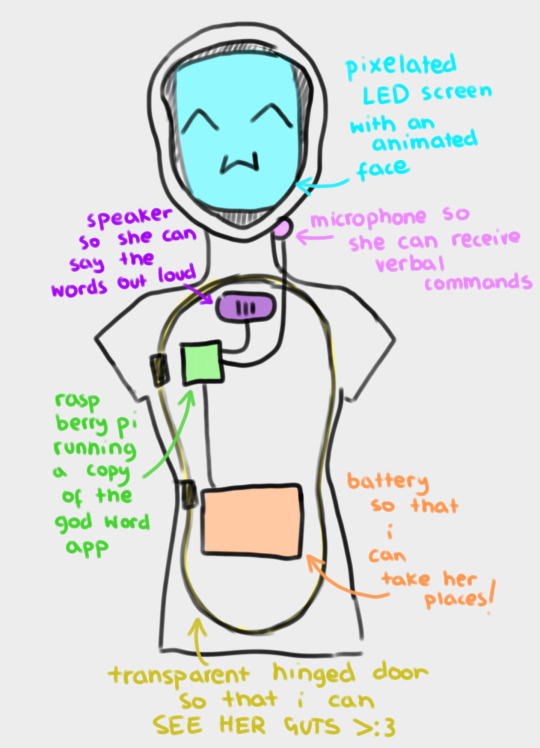
(image id available through tumblr's accessibility options)
this is a slightly revised version of my original concept for "APRIL".
the main functionality i wanted for "APRIL" was for her to be able to read out words from the templeOS god word app, and ideally without needing keyboard input – hence the microphone. ideally all of her parts are going to fit inside a hollowed out mannequin or doll, which will probably just be the torso, so that she's more portable. for the same reason, i want her to run off a power bank – i want to be able to take her places!
if we manage, we're going to give her an animated LED face which moves to indicate when she's speaking. the way i first pitched it, i wanted it to also change a bit depending on how she "felt" – for example, frowning if the environment was hotter than ideal for the raspberry pi to operate on. but that's a bit beyond our current scope right now. i don't think we even ordered a thermostat.
scott drew the following wiring diagrams based off my original sketch. here revised digitally for readability's sake.
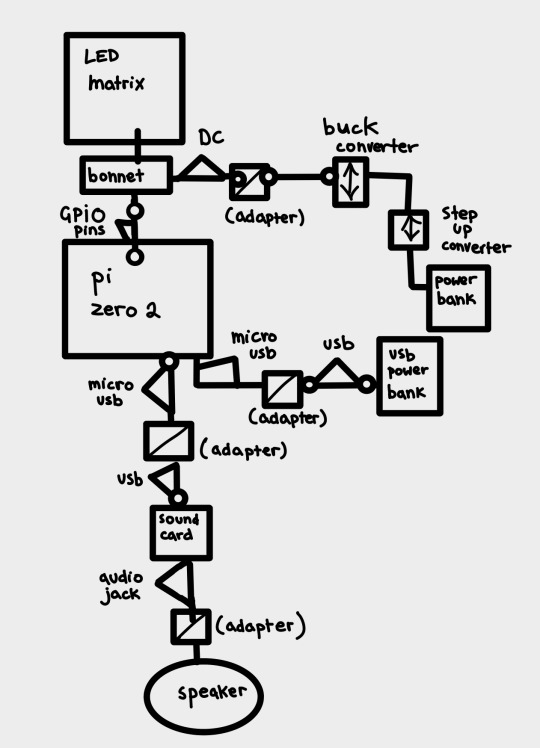
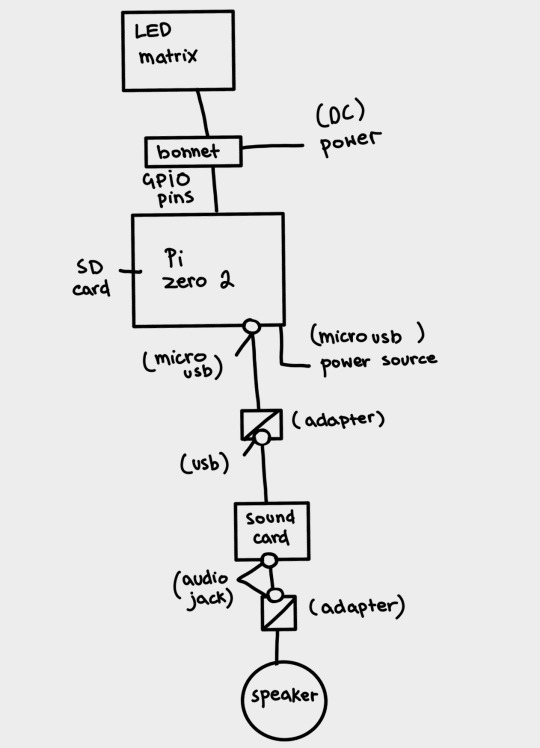
(image id available through the tumblr accessibility options although i fear it's not very good in this case. feedback appreciated).
scott: I decided to go with the raspberry pi zero 2w because it's what I've got experience coding on, it's relatively cheap for the "brains" of the operation (heh) and can perform both tasks from the godword prophecy generation, speaker operation and led matrix operation simultaneously. Plus its small enough to keep the circuit lightweight and fit inside the initial mannequin design.
This drawing fits no kind of engineering standard by the way lol. It was an initial sketch closer to a wiring diagram to see how it'd physically setup and wrap my head around transforming it from mains power to being theoretically portable and running on powerbanks. Unfortunately the LED matrix is really fucking power hungry so needs its own power supply of really specific voltage and current draws hence all the converters.
Also because Im using the smaller and cheaper pi, as oppossed to a stronger system like the pi4, it doesn't have any audio out jack so I plan to use the micro usb for audio out which means yet again I need another adapter for a soundcard and usb to micro usb adapters and all that jazz. Usually sound out can be done through the GPIO pins but the LED matrix takes so many pins that I cant really take anything form them so I had to look for other ways of doing it. Plus this way I get to add a soundcard so if we wanna add microphone support or anything later on we can :)
(Also this is all a little obtuse because I'm trying to do it as much as plug and play and screw terminal style as possible rather than actually solder connections for ease of access and initial setup, but this also works for modular design and component swapping later too so its cool.)
preacher: another reason we're going with plug&play is becauuseeeeee i don't own a soldering iron 😭 it's ok. it's ok.
our silly initial drafts under the cut for your viewing pleasure.

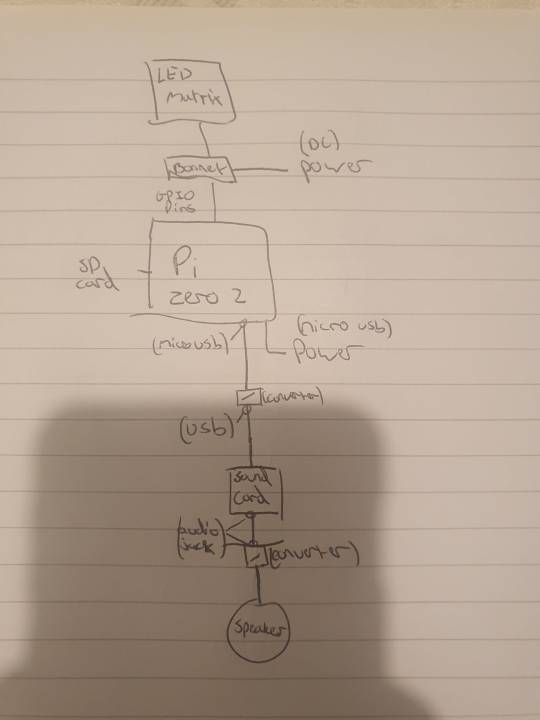
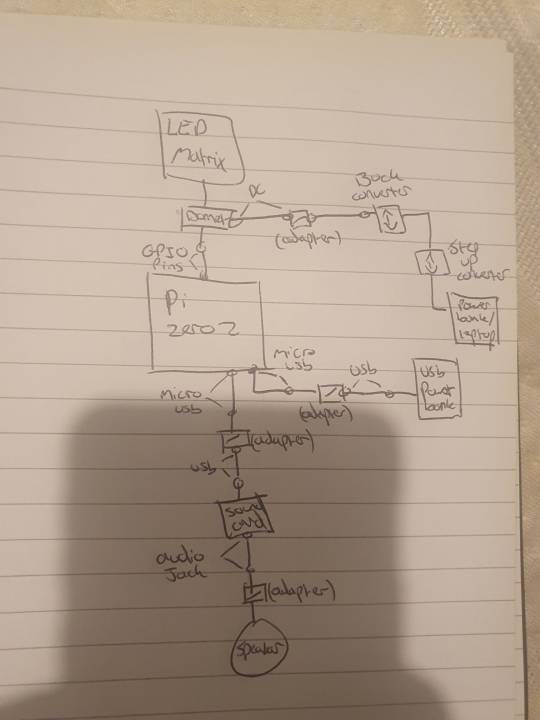
preacher: these were made around 2 weeks ago, so about september 15th ish.
as you can see the first "APRIL" drawing was beautifully drawn with my fat fingers in the facebook messenger photo editor. i think it holds up. lol.
#computers#computer#programming#software engineering#robots#robotics#raspberry pi#robot girl#machine#machines#divine machinery#tech#technology#techcore#machinecore#objectum#objectophilia#robophilia#techum#technum#android#gynoid#mechanical divinity#templeos#coding#scott#preacher#drafts#update#roadmap
30 notes
·
View notes
Text
... As he continued making games, Wright would become inspired by the postwar architect Christopher Alexander, whose 1977 book A Pattern Language became a cult manual for city design. It divided metropolitan life into modular elements—“SMALL PUBLIC SQUARES,” “GREEN STREETS,” “SHOPPING STREET”—and then instructed readers on how they should be combined. In this approach an environment became an almost mathematical operation: “Each pattern describes a problem which occurs,” Alexander writes, “and then describes the core of the solution to that problem, in such a way that you can use this solution a million times over, without ever doing it the same way twice.”
Maxis was acquired by EA in 1997; three years later Wright released The Sims, the ur-game, a simulation of humanity itself. In the same way that Alexander proposed curating infinite variety under a standardizing aegis, so could the components of The Sims be shuffled and toggled into ever-proliferating realities. Wright had lost his home in the Oakland firestorm of 1991, and has said that the original purpose of The Sims was to simulate the building and designing of houses. Indeed, the game maintains a lasting obsession with real estate. To play a family one must buy a home, and a home in The Sims is like a zen garden: obsessively tended to, an object of constant maintenance and contemplation. One can spend hours surveying possible wallpaper choices or creating a painstakingly gabled roof. In a 2022 oral history published by Vice, the franchise’s first art director, Charles London, said that The Sims was meant to be “an architecture game.” Little characters were added to “score” the design choices, only to eventually become the main feature and appeal.
Some commentators believe that The Sims is meant to satirize suburbia. “The boredom, the sterility, the uselessness and the futility of contemporary life,” writes the media scholar Alexander Galloway, “are depicted precisely using the things that represent it best: a middle-class suburban house, an Ikea catalogue of personal possessions, crappy food and even less appetizing music, the same dozen mindless tasks over and over.” Others have argued that the game is more sincere, a naif’s tribute to property ownership and what one gaming website calls its “beautiful scenery and idyllic backdrops.” There are listicles, Reddit threads, and YouTube channels dedicated to ranking and showcasing Sims mansions, guided by the same voyeurism as the tours of real houses in Architectural Digest.
But Wright, who left EA in 2009, did not give these manicured pixels a matching suburban ethos. A home in The Sims lacks the usual animating forces of family life. Intimacy between relatives is measured in points, increasing or decreasing without any given injury or kindness settling into a memory. A Sims home is not a haven or stage for emotions; it is only a system that challenges players to maintain its various parts. The game’s characters therefore never seem to experience the ongoing dramas of domesticity—neither its tender feelings nor its threat of betrayal, violence, resentment, dependency, scandal, and mutual ruination. As London put it, Sims characters, in their levels of happiness, signify the “efficient choices” a user makes in “object placement and room design.” The game, in effect, exports the density and urgency of the city and its management to the suburbs. The toilet, the refrigerator, and the bed are the chief fixtures of the game, meant to be visited in efficient choreographies of clicking.
This is, ultimately, less a narrative project than an ecological one. The Sims is about holistic relations, the quick and at times perilous responsiveness of one part of the whole to another. A Sim’s mood will plummet if her house is poorly decorated, or if she hasn’t taken the garbage out, or if, in an effort to learn a skill, she’s forgotten to fulfill a need. This kind of hair-trigger existence may explain the impulse that so many players cite of wanting to set their Sims on fire or drown them in swimming pools. Contra popular belief, these users are not behaving like psychopaths so much as feeling an understandable reflex toward entropy. One desires to see the system lurch into breakdown, to dash the finely made dollhouse into pieces...
... One helps a Sim by employing an algorithm, which is often the same thing as internalizing it. Far from providing a nostalgic refuge from the contemporary Internet, in other words, The Sims taps into one of the Web’s most foundational assumptions: that the processes of thinking and producing can be reduced to a series of commands. The user, in this view, becomes more creative as she becomes more machine-like. The rules allow her to manufacture possibilities; she is less an author employing technology for her own ends than an emitter of inputs, a conscript of the machine’s algorithmic logic.
Nowhere is that logic more apparent than in generative AI. At its most basic an algorithm is a set of instructions for achieving a designated result, such as the prompt that one might use to generate email text, say, or an atrocity photo in the style of Hayao Miyazaki. In 2018 Will Wright announced his first project in years, a game called Proxi, which has still yet to appear. In it, players will use AI to build animated scenes based on their memories, which they can then tweak and modulate as they wish.
8 notes
·
View notes
Text
Updating organization at the Adabench for the New Year This coming year, we wanted to update our storage and organization: with about 700 original designs, a couple dozen in progress, and thousands of items in the shop, it's hard to keep track of all the components and devboards we need to test various combinations. Historically, we've used double-sided totes
, which are good, but the double-sidedness is a bit annoying, or the little divider boxes for small breakouts
, and snap-top boxes for SMT components
But all these cases were sort of swimming around, and it was getting unwieldy. We're going to try to use the large IKEA ALEX drawers
- we like them cause they're wide and thin - and maybe use something like gridfinity
to make a flat storage surface so we can quickly find any PCB or part we need.
#organizationgoals#newyearupdate#storagesolutions#adabench#electronicsworkshop#ikeaalex#gridfinity#pcbdesign#electronicsorganization#diysetup#makerspace#storageideas#workspacegoals#creativesolutions#tidyworkspace#storagehacks#diyorganization#electronicsprojects#smallpartsstorage#modularstorage#ikeahack#makersgonnamake#storagetips#workshopsetup#designworkflow#electronicslab#tidyup#workspaceinspo#makerslife#organizedworkshop
18 notes
·
View notes
Text
The Difference Between Low, Medium, and High Voltage Switchgear

Switchgear plays a critical role in the generation, transmission, and distribution of electrical power. It ensures safe and efficient operation by controlling, protecting, and isolating electrical circuits and equipment. But not all switchgear is created equal — low, medium, and high voltage switchgear are designed for different voltage levels and applications.
Understanding the differences between these types is crucial for electrical engineers, electricians, project managers, and anyone involved in power systems. In this article, we break down what sets them apart in terms of voltage range, components, applications, design, and safety considerations.
What is Switchgear?
Before diving into the differences, let’s clarify what switchgear is.
Switchgear refers to the combination of electrical disconnect switches, fuses, or circuit breakers used to control, protect, and isolate electrical equipment. It is essential for de-energizing equipment for maintenance and for clearing faults in the power system.
Classification by Voltage Level

Low Voltage Switchgear (LV)
Voltage Range:
Up to 1,000V AC (typically 400V/690V in 3-phase systems)
Key Components:
Miniature Circuit Breakers (MCBs)
Molded Case Circuit Breakers (MCCBs)
Residual Current Devices (RCDs)
Contactors and relays
Busbars, metering, control panels
Applications:
Residential and commercial buildings
Data centers and office spaces
Light industrial automation
Control panels and motor control centers (MCCs)
Characteristics:
Compact and easy to install
High frequency of operation
Relatively simple maintenance
Often enclosed in modular panels
Standards:
IEC 61439
NEC (National Electrical Code)
Medium Voltage Switchgear (MV)
Voltage Range:
1kV to 36kV (sometimes up to 72.5kV)
Key Components:
Vacuum circuit breakers (VCBs)
SF₆ (sulfur hexafluoride) insulated switchgear
Current and voltage transformers (CTs, VTs)
Protective relays
Grounding switches
Applications:
Electrical substations
Large factories and industrial plants
Railways and airports
Renewable energy farms (wind/solar)
Characteristics:
Higher insulation and safety requirements
More robust protection systems
Often installed indoors or in compact outdoor enclosures
May use gas-insulated or air-insulated designs
Standards:
IEC 62271–200
IEEE C37 series
High Voltage Switchgear (HV)
Voltage Range:
Above 36kV (commonly 66kV, 132kV, 220kV, up to 765kV)
Key Components:
SF₆ circuit breakers
Air blast or oil circuit breakers (older systems)
Gas-insulated switchgear (GIS)
Disconnectors and earthing switches
High-end protection relays and SCADA integration
Applications:
National and regional power transmission networks
Power generation plants
Interconnecting large substations
Critical infrastructure (e.g., large data centers, airports)
Characteristics:
Complex installation and high-cost infrastructure
Requires rigorous safety procedures and specialized training
Often installed outdoors or in GIS (Gas Insulated Switchgear) format
Includes extensive monitoring and automation
Standards:
IEC 62271–100 (HV circuit breakers)
IEEE C37.06
ANSI C37 series
Safety Considerations

Always follow local electrical codes, use personal protective equipment (PPE), and conduct routine maintenance regardless of switchgear type.

Conclusion
Choosing the right switchgear type is critical for ensuring safe and efficient power distribution. Whether you’re designing a residential panel or a high-voltage substation, knowing the difference between low, medium, and high voltage switchgear helps you make informed decisions about equipment, safety, and performance.
Mastering this knowledge isn’t just good practice — it’s essential for anyone serious about a career in the electrical field.
10 notes
·
View notes
Text
Switchgear Solutions for Solar and Wind Energy Systems

Why Switchgear Matters in Solar and Wind Systems
Switchgear plays a central role in controlling, isolating, and protecting electrical equipment. In renewable energy applications, it helps:
· Manage power flow from variable energy sources.
· Protect systems from faults or overloads.
· Ensure seamless grid integration and disconnection when needed.
Unlike traditional power plants, solar and wind systems generate intermittent power, requiring switchgear that can handle dynamic loads and frequent switching.
Challenges in Renewable Energy Applications
Here are some of the unique challenges renewable energy systems face — and how they impact switchgear selection:
1. Variable Output
Solar and wind energy production fluctuates based on weather and time of day. This demands switchgear that can:
· Handle frequent load changes.
· Operate reliably under fluctuating voltages and currents.
2. Decentralized Generation
Unlike centralized grids, solar and wind systems are often spread out across multiple locations.
· Modular, compact switchgear is preferred for such installations.
· Smart monitoring becomes critical to manage performance remotely.
3. Harsh Environments
Wind turbines operate at high altitudes, and solar farms are often exposed to heat, dust, or salt.
· Switchgear needs to be rugged, weather-resistant, and have high IP ratings.
· Outdoor switchgear enclosures and temperature management are essential.
Key Features of Switchgear for Solar & Wind
When designing or upgrading renewable energy systems, look for switchgear that offers:
1. Remote Monitoring and Control
Smart switchgear integrated with IoT technology allows operators to track real-time data, detect faults early, and optimize system performance.
2. High Interruption Capacity
Wind and solar systems may experience voltage spikes. Modern switchgear provides high breaking capacities to safely interrupt fault currents.
3. Modular Design
Allows for easy upgrades and maintenance — crucial for scaling renewable installations.
4. Eco-Friendly Design
Look for SF₆-free switchgear that uses clean air or other sustainable alternatives to reduce environmental impact.
5. Hybrid Capabilities
Switchgear that can connect both AC and DC sources is increasingly valuable in mixed-source grids.
LV, MV, and HV Switchgear for Renewables
· Low Voltage (LV) Switchgear: Used in residential or small-scale solar systems. Compact, safe, and cost-effective.
· Medium Voltage (MV) Switchgear: Ideal for commercial and industrial solar/wind applications.
· High Voltage (HV) Switchgear: Essential for utility-scale wind farms or solar plants feeding into the national grid.
Each type requires specific protection, metering, and automation components tailored to its load and system requirements.
Final Thoughts
Switchgear is the backbone of any successful solar or wind energy system. As these technologies become more mainstream, the demand for resilient, intelligent, and environmentally friendly switchgear solutions will continue to rise.
Whether you’re an energy consultant, project developer, or facility manager, choosing the right switchgear today will set the stage for long-term efficiency, safety, and scalability.
8 notes
·
View notes
Text

DUNE scientists observe first neutrinos with prototype detector at Fermilab
Symmetry magazine,
The prototype of a novel particle detection system for the international Deep Underground Neutrino Experiment successfully recorded its first accelerator neutrinos.
In a major step for the international Deep Underground Neutrino Experiment, scientists have detected the first neutrinos using a DUNE prototype particle detector at the US Department of Energy’s Fermi National Accelerator Laboratory.
DUNE, currently under construction, will be the most comprehensive neutrino experiment in the world. It will bring scientists closer to solving some of the biggest physics mysteries in the universe, including searching for the origin of matter and learning more about supernovae and black hole formation.

Display of a candidate neutrino interaction recorded by the 2×2 detector highlighting the four internal detector modules and native 3D imaging capability. The bottom image additionally shows the detectors surrounding the 2×2 for further tracking of incoming and exiting particles. The DUNE Near Detector will similarly consist of a modular liquid argon detector along with a muon tracker.
Courtesy of DUNE Collaboration
Since DUNE will feature new designs and technology, scientists are testing prototype equipment and components in preparation for the final detector installation. In February, the DUNE team finished the installation of their latest prototype detector in the path of an existing neutrino beamline at Fermilab. On July 10, the team announced that they successfully recorded their first accelerator-produced neutrinos in the prototype detector, a step toward validating the design.
“This is a truly momentous milestone demonstrating the potential of this technology,” says Louise Suter, a Fermilab scientist who coordinated the module installation. “It is fantastic to see this validation of the hard work put into designing, building and installing the detector.”
The new neutrino detection system is part of the plan for DUNE’s near detector complex that will be built on the Fermilab site. Its prototype—known as the 2×2 prototype because it has four modules arranged in a square—records particle tracks with liquid argon time projection chambers. The final version of the DUNE near detector will feature 35 liquid argon modules, each larger than those in the prototype. The modules will help navigate the enormous flux of neutrinos expected at the near site.
The 2×2 prototype implements novel technologies that enable a new regime of detailed, cutting-edge neutrino imaging to handle the unique conditions in DUNE. It has a millimeter-sized pixel readout system, developed by a team at DOE’s Lawrence Berkeley National Laboratory, that allows for high-precision 3D imaging on a large scale. This, coupled with its modular design, sets the prototype apart from previous neutrino detectors like ICARUS and MicroBooNE.
Now, the 2×2 prototype provides the first accelerator-neutrino data to be analyzed by the DUNE collaboration.
DUNE is split between two locations hundreds of miles apart: a beam of neutrinos originating at Fermilab, close to Chicago, will pass through a particle detector located on the Fermilab site, then travel 800 miles through the ground to huge detectors at the Sanford Underground Research Facility in South Dakota.
The DUNE detector at Fermilab will analyze the neutrino beam close to its origin, where the beam is extremely intense. Collaborators expect this near detector to record about 50 interactions per pulse, which will come every second, amounting to hundreds of millions of neutrino detections over DUNE’s many expected years of operation. Scientists will also use DUNE to study neutrinos’ antimatter counterpart, antineutrinos.
This unprecedented flux of accelerator-made neutrinos and antineutrinos will enable DUNE’s ambitious science goals: Physicists will study the particles with DUNE’s near and far detectors to learn more about how they change type as they travel, a phenomenon known as neutrino oscillation. By looking for differences between neutrino oscillations and antineutrino oscillations, physicists will seek evidence for a broken symmetry known as CP violation to determine whether neutrinos might be responsible for the prevalence of matter in our universe.
The DUNE collaboration is made up of more than 1,400 scientists and engineers from over 200 research institutions. Nearly 40 of these institutions work on the near detector. Specifically, hardware development of the 2×2 prototype was led by the University of Bern in Switzerland, DOE’s Fermilab, Berkeley Lab and SLAC National Accelerator Laboratory, with significant contributions from many universities.
“It is wonderful to see the success of the technology we developed to measure neutrinos in such a high-intensity beam,” says Michele Weber, a professor at the University of Bern—where the concept of the modular design was born and where the four modules were assembled and tested—who leads the effort behind the new particle detection system. “A successful demonstration of this technology’s ability to record multiple neutrino interactions simultaneously will pave the way for the construction of the DUNE liquid argon near detector.”
Next steps
Testing the 2×2 prototype is necessary to demonstrate that the innovative design and technology are effective on a large scale to meet the near detector’s requirements. A modular liquid-argon detector capable of detecting high rates of neutrinos and antineutrinos has never been built or tested before.
The existing Fermilab beamline is an ideal place for testing and presents an exciting opportunity for the researchers to measure these mysterious particles. It is currently running in “antineutrino mode,” so DUNE scientists will use the 2×2 prototype to study the interactions between antineutrinos and argon. When antineutrinos hit argon atoms, as they will in the argon-filled near detector, they interact and produce other particles. The prototype will observe what kinds of particles are produced and how often. Studying these antineutrino interactions will prepare scientists to compare neutrino and antineutrino oscillations with DUNE.
“Analyzing this data is a great opportunity for our early-career scientists to gain experience,” says Kevin Wood, the first run coordinator for the 2×2 prototype and a postdoctoral researcher at Berkeley Lab, where the prototype’s novel readout system was developed. “The neutrino interactions imaged by the 2×2 prototype will provide a highly anticipated dataset for our graduate students, postdocs and other young collaborators to analyze as we continue to prepare to bring DUNE online.”
The DUNE collaboration plans to bombard the 2×2 prototype with antineutrinos from the Fermilab beam for several months.
“This is an exciting milestone for the 2×2 team and the entire DUNE collaboration,” says Sergio Bertolucci, professor of physics at the University of Bologna in Italy and co-spokesperson of DUNE with Mary Bishai of Brookhaven National Laboratory. “Let this be the first of many neutrino interactions for DUNE!”
w
#science#space#astronomy#physics#news#nasa#astrophysics#esa#spacetimewithstuartgary#starstuff#spacetime#hubble space telescope#jwst#fermilab
20 notes
·
View notes
Text
UNIX vs Linux

While studying my first lecture of the Linux course, I noticed that the lecture notes always referred to Linux (UNIX). This made me confused about whether Linux and UNIX are the same thing. After conducting some research, here's what I found:
UNIX was created before Linux. UNIX is an operating system that was developed in the 1960s and 1970s at Bell Labs. It was designed to be a portable, multi-user, and multitasking operating system. UNIX became widely adopted and influenced the development of many other operating systems, including Linux.
On the other hand, Linux was created in 1991 by Linus Torvalds as a free and open-source operating system. Linus Torvalds developed the Linux kernel, which is the core component of the operating system. Linux was inspired by UNIX and aimed to provide similar functionality and design principles while being accessible to a broader audience.
There are some key differences between the two:
Licensing: UNIX is a proprietary operating system, and its source code is not freely available. In contrast, Linux is open-source, which means its source code is available for anyone.
Kernel Design: The kernel design of UNIX and Linux differs. UNIX typically uses a monolithic kernel. Linux, on the other hand, uses a modular monolithic kernel.(I'll explain this in another post)
Command Line Interface: While both UNIX and Linux provide a command line interface, UNIX systems often have their own set of commands and tools, while Linux distributions commonly include the GNU utilities, which provide a comprehensive set of command-line tools.
Availability and Community Support: UNIX is typically associated with commercial offerings from companies . In contrast, Linux has a wide range of distributions that are freely available and supported by vibrant communities.
youtube
#linux#arch linux#ubuntu#debian#code#codeblr#css#html#javascript#java development company#python#studyblr#progblr#programming#comp sci#web design#web developers#web development#website design#webdev#website#tech#html css#learn to code#Youtube
115 notes
·
View notes
Text
"Suiting Up for the Fu
The screen lit up with the stark, clinical brilliance of a defense contractor’s marketing reel. Crisp graphics swept across the frame: Republic Integrated Systems Presents: The Future of Excellence—The Mark IV Full-Body Armor.The voiceover began with the smug confidence of a salesman who knew his product had no competition.

“For cadets like C9J18, the Mark IV Armor isn’t just equipment—it’s a way of life. Engineered for total integration, unmatched efficiency, and unwavering loyalty, the Mark IV is the pinnacle of personal enhancement technology. Let’s take a tour.”
The scene shifted to C9J18 standing at attention, his visor down, the black armor hugging every contour of his augmented frame. Overlaid on the screen was a breakdown of his suit’s components, sleek lines pointing to each piece as the voice detailed their functions.
“From head to toe, the Mark IV transforms the wearer into the perfect operator. Modular plates provide full ballistic, environmental, and impact protection, while maintaining unparalleled flexibility and comfort. The suit isn’t just worn—it becomes an extension of the body.”

The camera zoomed in as C9J18 moved through his day, transitioning to his POV. The HUD was alive with information: telemetry readouts, vital signs, suit status. The Contextual Priority Filter immediately began working, greying out the irrelevant clutter of the world—background conversations, unimportant scenery, even the faint hum of distant machinery.
“With the Contextual Priority Filter, cadets only see what matters. The AI-driven system dynamically adjusts the wearer’s perception, ensuring absolute focus on mission-critical elements. Irrelevant distractions? Eliminated. Productivity? Maximized.”
C9J18’s HUD highlighted his fellow cadets, their alphanumeric IDs glowing softly above their heads. An order appeared in bold text across the top of his visor: Form up. Begin sprint drills. The cadet turned on his heel, his movements precise, his focus razor-sharp as the HUD traced his optimal path.

“Every action is guided by the Task Assignment System, seamlessly integrated with the suit’s neural interface. Orders are delivered directly to the wearer, ensuring immediate compliance and zero ambiguity. Whether it’s a drill or a live operation, the system ensures cadets are always one step ahead.”
The screen flickered to an instructor’s POV. The Drill Instructor’s helmet HUD displayed all cadet vitals, suit status, and performance metrics in real-time. The instructor’s voice cut through the comms channel, amplified by the suit’s audio system. “Pick up the pace, C9J18. You’re at 85% efficiency—I want 95 by the next lap.”
“Supervisors can control multiple cadets at once,” the voiceover explained, “adjusting suit parameters on the fly. Need to increase resistance for endurance training? Done. Reduce sensory input to prevent distractions? Easy. With the Mark IV, instructors don’t just teach—they sculpt.”

C9J18’s breathing was steady as he pushed through the sprint drill. His suit’s Sensory Regulation System muted the ache in his muscles, dampening the sensation of fatigue just enough to keep him going without compromising performance.
“The Sensory Regulation System is a game-changer,” the voiceover continued. “It modulates physical sensations, ensuring optimal performance. Pain, heat, cold—it’s all calibrated to the mission. The suit doesn’t just protect—it conditions.”
The scene transitioned to the mess hall, where C9J18 and his peers sat in silence, eating their nutrient-rich chow. The HUD overlay highlighted their calorie intake, hydration levels, and metabolic efficiency. Even here, the Contextual Priority Filter ensured no unnecessary conversation or stimuli distracted from their task.
“Nutrition is monitored in real-time, ensuring each cadet receives exactly what their body needs. The suit tracks digestion, energy expenditure, and even waste management, all while maintaining seamless integration with the wearer.”
As the day wound down, the footage shifted to the barracks. The cadets moved in synchronized silence, stepping into individual alcoves built into the walls. The HUD displayed a notification: Sleep Mode Engaged. C9J18 lay back in his suit, his visor darkening as the comms went silent.
“When the day is done, the Mark IV ensures uninterrupted rest. Fully equipped with climate control and biometric monitoring, the suit provides optimal conditions for recovery—even in full armor. The visor’s sleep mode darkens gradually, synchronizing with neural rhythms to lull the wearer into rest.”
The camera lingered on C9J18 as his breathing slowed, his face calm beneath the visor. The overlay showed his heart rate stabilizing, stress levels dropping, and compliance metrics holding steady. The AI’s gentle hum was a constant presence, even in sleep.

“From dawn to dusk, and even through the night, the Mark IV is more than just a suit—it’s a system. A revolution. A future.”
The screen cut to the Intelligence Conscript and K7L32, standing side by side, both suited up, their visors up to reveal their shaved heads and sharp, cynical smiles.
“Of course,” K7L32 said with a mocking tone, “it’s not just about the tech. It’s about the transformation. You don’t just wear the suit—you become it. Isn’t that right, sir?”
The Intelligence Conscript chuckled, his voice dripping with sardonic amusement. “That’s right, cadet. The Mark IV doesn’t just enhance—it defines. And for cadets like C9J18, it’s the beginning of a life dedicated to the Republic. Efficient. Loyal. And, best of all... compliant.”
The screen faded to black, the final words scrolling across in bold, unyielding font:
The Mark IV Armor Suit: Not Just a Tool—A Way of Life.
6 notes
·
View notes
Text
SAVANNAH - REVELATION
[Argo internal monitoring system - record created 16.04.3025 - record last accessed 21.05.3060 - record accessed by: Precentor Omicron (PX) VI Liška]
[Record Location - MechBay Chief Tech Office - assigned to Y. Virtanen]
[sound of hatch opening]
Savannah Caruso [SC]: You called for me, Yang?
Yang Virtanen [YV]: Uh - yeah, boss, come on in. And close the hatch, wouldya?
[sound of hatch opening fully and closing, followed by locking sound]
SC: Okay, Yang, you were pretty hush-hush. Keting xox? [trans. “Lang Belta”: “What’s up?”]
YV: It, uh, it’s about the new guys, boss.
SC: Our weird’uns?
YV: Uh, well, Melissa and her little clique, yeah. I know when we hired ‘em, them said, “don’t ask questions-”
SC: But you’ve been asking anyway.
YV: Uh - yeah. No, not asking questions, but investigating. I just didn’t buy their story. At first just about their ‘Mechs. I mean there’s lots of Belters out there that, well, uh. Go like you. Go furry.
SC: Yeah, pretty common. Okay, so you didn’t buy their story. You don’t think those new ‘Mechs are old SLDF prototypes?
YV: No, ma’am, I don’t. And I can prove that - and a lot more.
SC: That so?
[sound of chair being pulled into position - followed by pause - 2 seconds]
SC: Okay. Go.
YV: All right, so the first thing that got me weirded out was the connectors. For the cables.
SC: [unidentifiable sound - pos. expression of interest]
YV: That and how clean everything is in those ‘Mechs - not clean, like, not dusty, but how… how uniform it all was. It’s all standardized. I don’t need to tell you what that means.
SC: Either these were newly built ‘Mechs and never saw action…
YV: … or wherever they came from has functional, fully standardized ‘Mech factories. Which… they have to be factory-built. They’re just not… messy enough for prototypes.
SC: Could be late stage prototypes? Near-production?
YV: See, I thought that too. But we’ve got two of those … [sound of snapping fingers, repeated 3 times]... “Catamarauders” out there -
SC: [interrupting; sound of snorted laugh]
YV: Well, I gotta call ‘em something, boss, and Melissa and her little menagerie aren’t naming names. Anyway, if those were prototypes, even late stage, I’d expect to find some kind of difference, even tiny ones.
SC: Well, the weapons load -
YV: [interrupting] I mean at the functional component level, boss. The screws, the connectors, the O-ring seals. They’re all identical, boss, even with connecting different weapons in.
SC: Okay. Serial numbers?
YV: Scrubbed. Completely. Lasered, sanded, dremeled off. Everything-
SC: [simultaneous] Hmm.
YV: - but all the locations of the serial numbers are identical. Part to part.
SC: Okay. Okay. So they’re not prototypes. So… Keting to showxa? [trans. “Lang Belta”: “What are you saying?”]
YV: What I’m saying is that those are production ‘Mechs. And they’re not SLDF. Not all of them.
SC: Okay. Elaborate.
YV: Obviously the Lancelot, Mongoose, and that Phoenix Hawk LAM are SLDF designs. Those are in the Argo’s databanks and we know them. But the others, we don’t know, right? Well, I’m certain the other ‘Mechs are based on Star League tech. I checked. The connectors and screws and such in the new ‘Mechs - dimension-wise, they’re perfect matches for SL-Standard components, but improved. Made out of some new material compounds and seemingly a little beefed up to allow for repeated swaps in and out -
SC: [interrupting] Like the weapons.
YV: Like the weapons, but at a smaller scale. Everything seems geared towards making refits easy. Like they’re expecting to do them often. And the old Star League had a couple designs that had modular weapon setups, but this is a lot more comprehensive. Plus the weapons themselves. What they’re calling a “small laser”? Boss, that thing pumps out as much energy as a medium laser, and range wise I’m seeing a 25% increase over a normal small. It does generate more heat, but that gets into discussing those compact double heat sinks they’ve got… all the weapons are like that. Same or reduced weight and space, better range, and for the energy weapons, better energy output. They’re just better, and I can’t explain it without what might seem like some logical leaps.
[silence - 3 seconds]
SC: So you’re saying that someone has a factory out there churning out ‘Mechs with components matching Star League standards, and with weapons that are lighter, less bulky and hit harder than standard designs.
YV: Yeah, and those new weapons, well, Melissa and her little group - the way they speak about our weapons? Those better weapons aren’t prototypes or sidegrades, boss. Wherever they come from, those are standard-issue.
SC: Okay, that’s… [exhale] Pashang mi, Yang. [trans. “Lang Belta’: “Fuck me, Yang.”] I’m beginning to get an idea of where you might be going here... [pause, ½ second] They were all really chuffed to get to ride on the Argo, weren’t they?
YV: They were, boss. They were. But, I’ve got more.
SC: Go go. [trans. “Lang Belta”: “Go on.”]
YV: I was born on Bryant, not all that far from Combine space. Spacers come through, we’d hear tales. I once heard a rumor about something that happened during the First Succession War. Mysterious raiders come out of the coreward Periphery. No communication. They attack four Combine worlds - Svelvik, Trondheim, Jarret, and Richmond. They have advanced tech, seemingly modified Star League kit. One of these raiders died on Richmond - driving a pristine Lancelot.
SC: [chair shifting]
YV: Yeah, a little like the one out there. This MechWarrior killed himself to avoid capture when his ‘Mech was disabled. Some kind of suicide pill, I heard. Anyway, the ‘Mech had two insignia on it - a white Terran wolverine with blood-covered fangs, and an insignia of a landmass with “331st” on it. And get this. The raiders ‘Mechs were painted in regular army colors - regular Star League army colors. Y’know, that one shade of green - and they used SLDF tactics in battle. Had advanced full body cooling suits, slimmer, more advanced than Inner Sphere standard. Not as advanced as what we have here on the Argo, but still.
SC: Sounds like the suits our new friends had when they joined us. When was this?
YV: 2825. Two hundred years ago exactly. I cross referenced those logo descriptions with the Argo’s computer library, boss. No dice on the wolverine logo, but the other one… belonged to the SLDF 331st Royal BattleMech Division. Minnesota Division.
[silence - 1.5 seconds]
SC: The 331st didn’t go Blue Star or ELH… did they.
YV: No, ma’am. All records stop when Kerensky left.
[silence - 2 seconds]
YV: Yeah. Still not done though.
SC: [nonplussed] Oh good.
YV: Y’know how the Argo, she has that funny little habit of sneaky copying the jump logs on JumpShips we dock with?
SC: I do. We get shit for it, but Doc Murad hasn’t figured out a fix yet?
YV: Yeah, well, it turns out that applies to DropShips too, when they dock with us. Including the one that Melissa and her group docked on way back when they joined up. I had Sumire pull up the records. They used the same DropShip for quite a while.
SC: And where did it come from?
YV: First record on the DropShip’s string is at Richmond, and the JumpShip made at least one jump rimward from the coreward Periphery before that.
[silence - 4 seconds]
YV: But I don’t think they’re this Minnesota group, boss. None of them had that logo anywhere on their ‘Mechs.
SC: They didn’t have ANY insignia, as I recall.
YV: Yeah. But that’s not the kicker, boss. I know who they came from, or at least, a 99% guess. When I was doing maintenance last week on Remus’ “Catamarauder”, I accidently tripped a memory dump. There were hidden files. Including the neural config file. You know how none of them have given us their last names?
SC: [hesitantly] I do…
YV: [pause, audible swallow] Makes sense they didn’t scrub it, it’s a key file, and one that you can’t just modify without root access, except by changing the neurohelmet sync, and even then it doesn’t... [shaking exhale] Well, on Remus’ ‘Mech… and probably all of them… well, their ‘Mechs have their names, listed right there in the neural config files. Remus’ last name… is Kerensky.
[silence - 2 seconds]
SC: … fffffuuuuuck.
7 notes
·
View notes